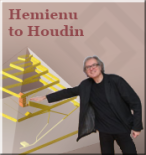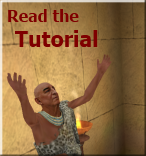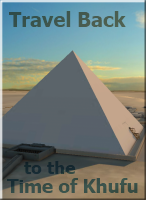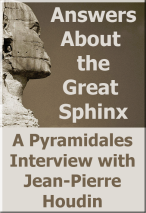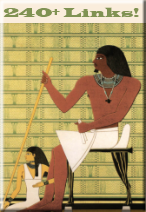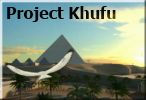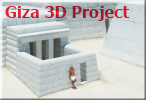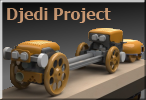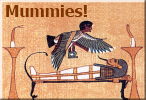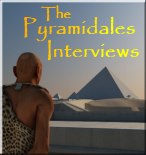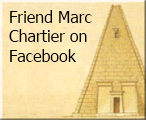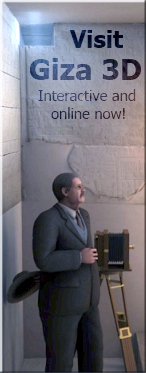 Last year during the premiere of Giza 3D, Marc Chartier of Pyramidales and I had a chance to talk with Egyptologist Rus Gant, lead technical artist for the Giza Archives Project and Giza 3D. In transcribing presentations from last year, I came across this fascinating “lost” discussion, and after working with Rus and Marc to clarify some points, we can now present it in an interview format for your enjoyment. From the resources used to create Giza 3D to George Reisner’s ongoing legacy, join us for a chat with Rus Gant.
Last year during the premiere of Giza 3D, Marc Chartier of Pyramidales and I had a chance to talk with Egyptologist Rus Gant, lead technical artist for the Giza Archives Project and Giza 3D. In transcribing presentations from last year, I came across this fascinating “lost” discussion, and after working with Rus and Marc to clarify some points, we can now present it in an interview format for your enjoyment. From the resources used to create Giza 3D to George Reisner’s ongoing legacy, join us for a chat with Rus Gant.
Em Hotep/Pyramidales: Giza 3D is about the most ancient past and the most modern technology coming together. One of the really interesting ways that modern technology is being used is in what is called “satellite archaeology”. How important is satellite imagery to Giza 3D?
Rus Gant: For modeling purposes we need the best satellite and aerial photography available. We have access to a very large collection of satellite photography from NASA and other sources, such as the German global view satellite which has 50 cm resolution and is available in stereo.
Em Hotep/Pyramidales: So your satellite imagery is better than Google Earth?
Rus Gant: Yes, much better. There is much better resolution and you can have it in different wavelengths—infrared, invisible light, we have a full range which is not available to Google Earth. In addition to satellite photography we have aerial photography and our GIS map database of over a hundred historical maps of Giza. We draw on all of these resources to build the model.
Em Hotep/Pyramidales: In this age of satellite photography, how important is aerial photography for building Giza 3D and surveying the Giza Plateau in general?
Rus Gant: The aerial photography is very important because we have it for over more than 100 years. For every two to three years we have a new aerial photograph so we can watch excavations, we can see the plateau change, roads come and go and the plateau evolves over time. The aerial photography is an incredibly good resource.
Em Hotep/Pyramidales: So the older and the newer aerial photography is useful?
Rus Gant: Yes. We even have photography from the German airship, Graf Zeppelin which visited the pyramids in 1931. We have images from two albums from passengers who were taking pictures as the zeppelin circled the pyramids. Of course they are not as useful as some of the other aerial photography because of the low resolution. The best is the military photography. We use photography from the RAF, from the German Air Force, the American Air Force, and the Egyptian Air Force. Even from World War I, the military back then had the best cameras, they were using very large plate cameras, so you have the best resolution.
Em Hotep/Pyramidales: What is one of the more interesting parts of Giza 3D to you?
Rus Gant: The settlement area in the Menkaure Valley Temple is one of the most interesting areas to me in a lot of ways. In the settlement area of the Valley Temple you have the closest representations of daily life in ancient Egypt at the time of the pyramids.
Em Hotep/Pyramidales: One does not normally think of a temple area as a settlement. Why would we have good settlement representation in Menkaure’s Valley Temple?
Rus Gant: Through much of its history the priests who were assigned to the temple had their living quarters in the courtyard, and so it was basically a ramshackle dormitory for priests. When George Reisner discovered the valley temple it had been buried for most of its’ existence, so the settlement area never eroded away. So outside of the builder’s village that Mark Lehner is excavating and documenting, the settlement area of Menkaure’s Valley Temple has some of the best settlement architecture and information we have from Giza. In fact, in some ways it is better preserved than Mark’s village. And of course Reisner reburied the temple site, so as Mark is re-excavating he is rediscovering what Reisner had reburied.
In Reisner’s notes there is a place where he said that they were reburying the area for protection of the monument remaining and because in 100 years they will know better how to excavate it and they will return. And he was right. Mark Lehner’s team returned in exactly 100 years—2010—and Reisner finished his excavation in April of 1910. And when Mark closes it up it will be set to come back to 100 years from now.
Em Hotep/Pyramidales: Is reburying a part of Reisner’s legacy? Don’t we do that today as well?
Rus Gant: Absolutely, backfilling is a protection mechanism, especially when you have mudbrick architecture, anything that can be eroded needs to be protected from the elements. Backfilling protects it. Also, reserving anywhere from 10 to 40 percent of the site for future excavation is now common. It is becoming much more normal now to excavate less of the site and instead do sampling, find the very specific things you want, and then leave large areas untouched for future archaeologists. So in that sense Reisner was quite ahead of his time with his methodology—not just with his recording techniques, but with his foresight to preserve the site for the future.
Em Hotep/Pyramidales: Does any other way come to mind in which Reisner was ahead of his time?
Rus Gant: Yes, in his combined scientific teams. By drawing in a variety of disciplines he was setting the standard for what would follow. A mixture of Egyptologists and specialists—pottery specialists, architects, artists… He was one of the first to create a major team like that. And now of course it has become standard.
Mehdi Tayoubi, Rus Gant and Peter Der Manuelian putting Giza 3D through a trial run at the Museum of Fine Arts Boston, 2012 (Photo by Anne Payne)
Copyright by Keith Payne and Marc Chartier, 2013. All rights reserved.
Images from Giza 3D copyrighted by Dassault Systèmes, Harvard University, and the Museum of Fine Arts Boston, used with permission, all rights reserved. All photography by Anne Payne is copyright by Anne Payne, all rights reserved. All other photography is in the public domain.
Tags: George Reisner, Giza 3D, Giza Plateau, Mark Lehner, Menkaure's Valley Temple, Rus Gant

